by Kitty Brayne, Country Coordinator, Madagascar
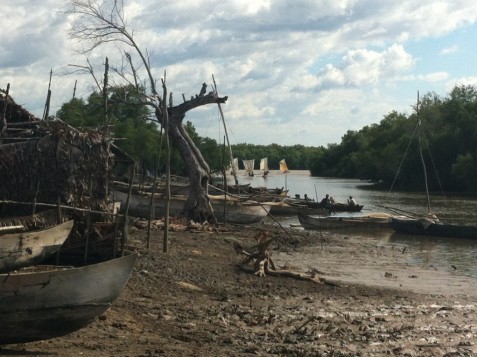
I’m in a fishing village, but I can’t see the sea. Ankazomborona is perched on the edge of a muddy channel separating land from a forbidding forest of twisted mangrove trees, their roots veering up in the quest for air in the thick dark mud.
Left: The tides are such that the fishers left the village at 4am, and are just starting to return as we arrive at 3 in the afternoon. Their pirogues float gracefully up the channel towards the village, and fishers unload their nets, wading through the calf-deep squelching mud.
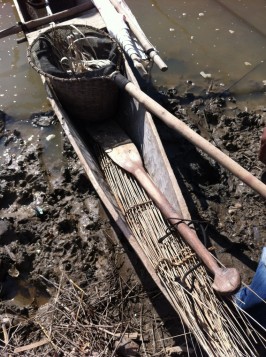 The communities around the Ambaro and Ambanja bays live off these mangroves; the murky waters within shelter crab, shrimp and fish which the villagers catch and sell, and provide a sheltered haven for fish to spawn, supplying the fisheries of the whole region.
The communities around the Ambaro and Ambanja bays live off these mangroves; the murky waters within shelter crab, shrimp and fish which the villagers catch and sell, and provide a sheltered haven for fish to spawn, supplying the fisheries of the whole region.
Charlie Gough and I are in Ankazomborona to coincide with a consultation run by the Blue Forests team to inform the community about a potential REDD+ project in the area. But as it’s our first visit to the area we take the opportunity to learn about its fisheries.
Right: In one pirogue we spot these materials used to make traditional large fish traps called kira. These funnel shaped traps are erected on the edge of mangroves to catch fish, shrimp and crab leaving the mangroves as the tide goes out. We are told that the traps would previously catch so much that you’d need to send a pirogue more than 10x to empty it. Now you’re lucky to fill one boat load.
![We meet Marie waiting to buy produce from the fishers to sell on. She shows us the basin of small catfish [Arius madagascariensis] she’s already bought. Marie explains that these fish are still babies, and emphatically demonstrates where a fully grown catfish would come to on her arm (about 3 times the length of these). She’s under no illusions about the effect of catching young fish on the fishery – explaining to me that these baby fish have not yet spawned before being caught and this is dangerous – but says you don’t find big fish anymore and she needs to make a living](http://blog.blueventures.org/media/2014/10/IMG_0176-477x357.jpg)
Charlie previously lived for a number of years in the Vezo fishing villages where Blue Ventures works in the southwest of Madagascar, and her curiosity to understand the fisheries up here in the northwest is infectious. “How did you catch this?”, “What’s the local name?”, “Where will you sell it?”…
Left: We meet Marie waiting to buy produce from the fishers to sell on. She shows us the basin of small catfish she’s already bought. She explains that these fish are still babies, and demonstrates how big a grown catfish would be (about 3x the size of these). She’s under no illusions about the effect of catching young fish on the fishery – explaining to me that these baby fish have not yet spawned before being caught and this is dangerous – but says you don’t find big fish anymore and she needs to make a living
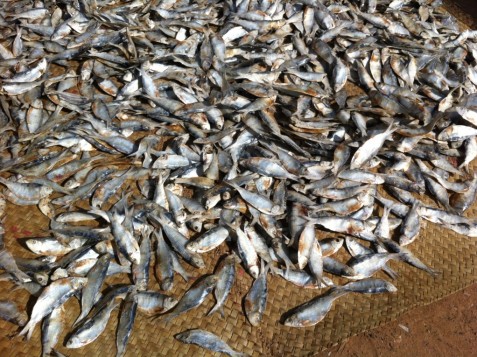 Blue Ventures’ work on mangroves is not only about securing carbon credits – we envisage this as just one tool in the box, one which we hope will finance conservation of this critical ecosystem. Fisheries are at the heart of what we do, so we’re also investigating how best to ensure fisheries management is at the heart of mangrove conservation in the region, learning from our experiences elsewhere in Madagascar.
Blue Ventures’ work on mangroves is not only about securing carbon credits – we envisage this as just one tool in the box, one which we hope will finance conservation of this critical ecosystem. Fisheries are at the heart of what we do, so we’re also investigating how best to ensure fisheries management is at the heart of mangrove conservation in the region, learning from our experiences elsewhere in Madagascar.
Above: All around the village we spot mats covered in dried fish of a range of species. Drying fish means it can be exported easily to regional hubs such as Ambilobe, Ambanja, Diego, Sambava, but it will get a lower price.
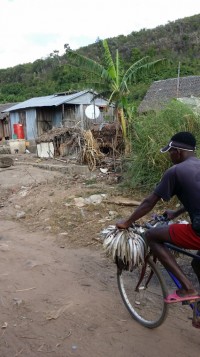 After meeting the president of the Comité Locale de Base, a community association which is taking a leading role in the conservation of the nearby mangroves (with the support of WWF), we meander slowly down the main through the village towards the economic hub of village life: the mangroves’ edge….
After meeting the president of the Comité Locale de Base, a community association which is taking a leading role in the conservation of the nearby mangroves (with the support of WWF), we meander slowly down the main through the village towards the economic hub of village life: the mangroves’ edge….
Left: Fish (laoko) that isn’t of value for export or suitable for drying is sold locally. These guys buy fish in Ankazomborona and then cycle around neighbouring villages selling a few fish in each, calling “Misy loako” as they go.
This short visit and the experiences of our team working in similar villages around the Ambaro and Ambanja bays tell us that local people have identified that their resources and livelihoods are in crisis. They have seen fish stocks crash in their own lifetimes and a parallel disappearance and degradation of vast areas of mangroves.
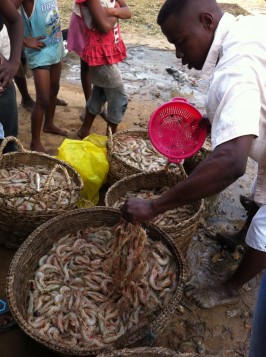 Our experience in the south west with octopus shows that identifying fisheries that respond to local management measures over short timescales is a successful way of catalysing long term community management of resources – a foot in the door. We are still at a very early stage in the northwest, but we hope to find similarly successful short-term fishery management measures here which will contribute to long-term management of mangroves in combination with sustainable finance mechanisms such the sale of carbon credits, preserving the vital ecosystem services these habitats provide.
Our experience in the south west with octopus shows that identifying fisheries that respond to local management measures over short timescales is a successful way of catalysing long term community management of resources – a foot in the door. We are still at a very early stage in the northwest, but we hope to find similarly successful short-term fishery management measures here which will contribute to long-term management of mangroves in combination with sustainable finance mechanisms such the sale of carbon credits, preserving the vital ecosystem services these habitats provide.
Right: On our way back, we meet a trader overseeing the packing and washing of shrimp in four large baskets. He has bought shrimp from twenty different pirogues today, but has only collected 200kg – these five baskets. He tells us that when he started out just one pirogue on its own could catch this same quantity in a day.
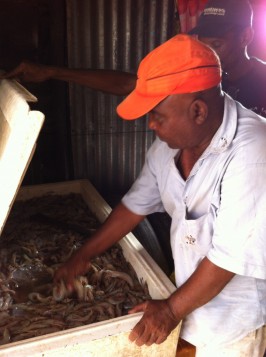 Note: You can help Blue Ventures secure funding to get a unique mangrove ecotourism project off the ground in the Bay of Ambanja. This project will allow tourists, students and locals to experience and learn about mangrove ecosystems, and provide another mechanism to finance conservation of this critical habitat by providing revenue to local communities. To make this happen we need your vote. Follow this link – it only takes 3 clicks! http://bit.ly/1djJmQh
Note: You can help Blue Ventures secure funding to get a unique mangrove ecotourism project off the ground in the Bay of Ambanja. This project will allow tourists, students and locals to experience and learn about mangrove ecosystems, and provide another mechanism to finance conservation of this critical habitat by providing revenue to local communities. To make this happen we need your vote. Follow this link – it only takes 3 clicks! http://bit.ly/1djJmQh
Left: Our collector aims to collect between 500kg and 1 tonne of shrimp to fill his truck and take to Diego where he sells to a Chinese buyer. He had already filled a chest freezer with catch from the previous days, so is ready to make the trip today.

